 |
 #INTHEAIREVERYWHERE
#INTHEAIREVERYWHERE |
|
| Vol.
17 No. 50 |
Monday
August 13, 2018 |
 |
|
“The
highlight for United Cargo in the first half
of 2018 was the continuation of the trend
that began in late 2014, when we emerged as
the clear leader among U.S. carriers in tonnage
carried and revenue.
“From
January through June, our ton miles increased
just over 6 percent while our revenues increased
nearly 19 percent,” declares United
Cargo President Jan Krems.
The
Natural At United Cargo
Jan Krems has
brought to United Cargo twin plus-factors:
an extensive air cargo management career and
an impressive intellectual background.
A native of
Oss, Netherlands, Jan is married with two
children and speaks five languages, including
his native Dutch.
A glance at
his advance toward the upper reaches of air
cargo professionalism reveals gradual, measured
progress: a swelling know-how gained at a
deliberate pace, like nature itself. Natura
non facit saltum, say the scholars, advising
that nature (i.e., maturity) makes no leap;
in nature things change gradually.
Jan is a force
of nature.
Of all the people
you have ever met in this business, Jan Krems
is a natural for the sort of air cargo work
required of him.
Trending
Upward
“We’re
quite proud of another ongoing trend: our
volume growth continues to exceed the 36 key
worldwide competitors measured by WorldACD.
“Demand
growth continued to be strong in the Asia
Pacific and Latin regions, although the pace
of growth slipped a bit from North America
and EMEIA,” Jan pointed out.
Giving
Credit Is Natural
“Of course,
we never forget that this success stands on
twin pillars.
“First,
there is the outstanding performance of our
Operations teams. United achieved the best
second-quarter on-time departure performance
in the company’s history, and our Cargo
Operations team continues to deliver the consistent
quality our customers demand.
“Next,
there is the personal quality of our customer
service provided by our Sales Team and support
staff.
“Anyone
who heard me speak on this subject,”
Jan insists,” knows my opinion that
United has the most talented and experienced
Sales Team in the business.
“Just
as important is that every team member shares
a commitment to exceeding our customers’
expectations every day.”
The
Switch Is On For Cool Cargo
“Reviewing
results for specific products and commodities,
our TempControl service for pharmaceuticals,
healthcare material, and other substances
needing temperature-sensitive shipping continued
to expand in every region.
“While
Europe and the U.S. continue to predominate
in the value of exported pharma, percentage-wise
our fastest growth in TempControl is in Asia-origin
business.
“We’re
also experiencing strong growth in pharma
imported into the Asia Pacific.”
Pharmerging
Opportunities Worldwide
“With
the quality reputation of our TempControl
service, and UA’s position as the leading
U.S. carrier to and from the Asia Pacific,
we are well-positioned to contribute to the
health of China’s people and to the
populations of other ‘pharmerging’
countries in the region.
“Along
with our nonstop focus on quality, I believe
TempControl shippers appreciate our drive
to continually add to and upgrade our packaging
and service options.”
Sonoco
Thermosafe Is A Gas
“The latest
example of that effort is the global lease
agreement with Sonoco ThermoSafe we announced
just a few weeks ago, which enables TempControl
customers to lease ThermoSafe’s PharmaPort
360 smart active shipping units from us.
“TempControl
customers also value our ongoing investment
in the human resources needed to ensure our
service consistently meets their needs.”
Field
of Dreams For Pharma
“United
has fielded a dedicated team of pharma business
experts in primary export countries around
the globe, and plans are in place to steadily
expand these teams.
“Since
life sciences logistics grows and evolves
at such a rapid rate, it’s essential
that we have specialists in continuous communication
with all participants in this supply chain
to keep our service relevant and valuable.”
The
Body Electric
Prior to his
ascent to the position at United, Krems spent
three years as president of the Americas for
Air France-KLM.
Working out
of Chicago in that job, he was an easy attraction
for the folks at United.
Krems had come
to regard KLM as his lifetime employer, and
he was ardent in his loyalty to the airline.
While he is
especially vocal in his praise and affection
for his team at United, Jan also stands up
for a small group of KLMers who, he said,
had a profound impact on his development as
a true professional: Jacques Ancher, Jan Meurer,
Enno Osinga, and Bram Gräber.
Given his heartily
expressed warm feelings toward KLM, his reasons
for accepting United’s invitation are
simple and direct.
“I decided
the time was right to make a change. No regrets,
either.
“KLM was
a great company to work for, and so is United.”
No doubt at
United Cargo, Jan has caught lightning in
a bottle.
As he continues
as top management his decency and humanity,
coupled with expertise and exuberance, will
help generate opportunities up and down and
all across the global United Cargo offering.
The
Joint Is Jumping
“A substantial
contributor to our success in 2018,”
Jan Krems smiles, “is our joint venture
with ANA Cargo.
“ANA and
UA just celebrated the two-year anniversary
of the cargo joint venture, which began in
July 2017 with eastbound service from Japan
to U.S. and Canada.
“We added
westbound transpacific routes from the U.S.
and Canada to Japan to the JV scope in February
2018, and in late May added eastbound transpacific
routes from Japan to Mexico.”
Expanding
Networks
The UA-ANA cargo
JV network now includes 377 nonstop flights
a week to 16 destinations and further flight
and truck connections within Japan, U.S.,
Canada—and now Mexico.
“Turning
toward Europe and our second JV, in early
May we reaped the reward for an enormous amount
of effort, energy, and skill from a multitude
of United and Lufthansa Cargo team members
when we launched the first phase of the UA-LH
Cargo joint venture cooperation.
“Since
then, we have gradually extended the scope
of our JV by adding more direct and transfer
routings between the U.S. and Europe to the
joint network.”
Ach
du lieber Lufthansa!
“The UA-LH
joint venture route network is already providing
greater flexibility and time savings to customers,
and we expect the fully implemented JV to
encompass approximately 1,500 new weekly route
combinations and approximately 600 additional
direct connections per week between the U.S.
and Europe.”
Even
More To Come
“Beyond 2018, we are looking forward
to developing many more expansion opportunities
for our JV network and we’re also evaluating
specialty products for possible future inclusion
in the JV.”
2018
Straight From The Shoulder
“The longer
I’m in the air cargo business—more
than 31 years at this point—the less
faith I have in my ability to make accurate
predictions.
“It’s
a challenge even in years when we don’t
have to weigh the impact of the trade tensions
looming over the second half of 2018.
“Factoring
in that uncertainty, plus the fact that trade
growth has slowed to where capacity is growing
faster than volumes, leads us to expect more
moderate gains in demand into the fall.
“Our conversations
with customers have us hopeful for another
positive peak season—with gains perhaps
less substantial than we enjoyed in 2017.
“The headwinds
are undeniable but, even if they slow down
growth a bit, we’re optimistic that
the overall positive trend will continue into
2019.”
That’s
Jan Krems, brother!
Geoffrey
|
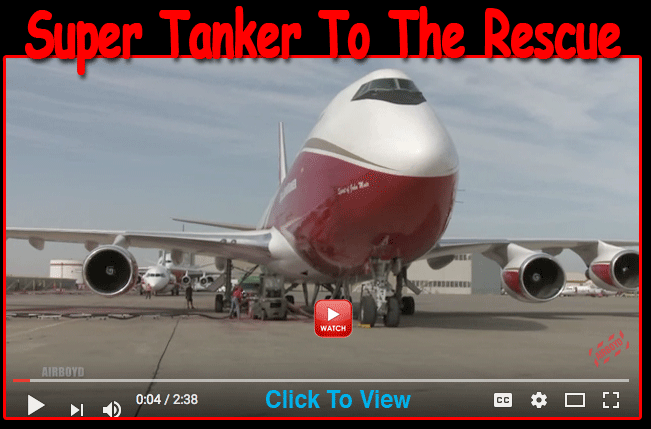
It had to happen
. . . Having served Japan Airlines for decades,
the venerable B747-400 has found another life—not
in air cargo, but converted into a tanker
that fights fires and saves lives in the western
United States.
In 2018 California is experiencing
its fiercest forest fires in history.
Yosemite Park is closed as the
state is burning north to south. From Klamath
National Forest to the Los Angeles metro area,
several fires are consuming an area larger
than New York City.
Elsewhere in Colorado, fires are also out
of control.
Enter the Global SuperTanker,
AKA “The Spirit Of John Muir,”
a privately owned rescue aircraft based in
Colorado.
The Global SuperTanker dwarfs
any other method of delivering either water
or fire suppressant. It is able to carry up
to 19,200 gallons at close to 600 mph.
https://www.youtube.com/watch?v=ygXto9jdQP0
|
 |
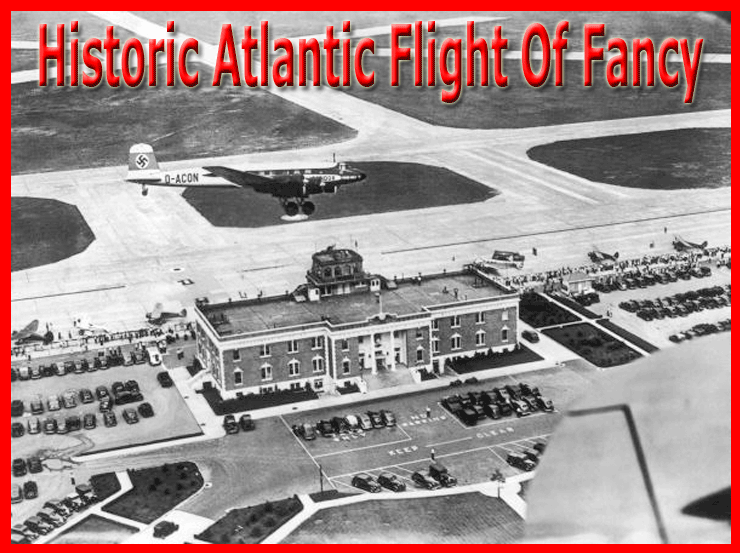
This past Saturday marked
the 80th anniversary of the first non-stop
transatlantic flight of a land-based passenger
aircraft to New York.
Landing at
Floyd Bennett Field in New York City on
August 11, 1938, just before 16:00 hours
local time, a Lufthansa four-engine Focke-Wulf
VI 200 “Condor,” registered
D-ACON & christened “Brandenburg,”
arrived from Berlin having flown 4,100 miles
(6,000 kilometers) non-stop across the Atlantic
in 24 hours and 57 minutes, at an average
speed of 164 MPH (263kmh/h).
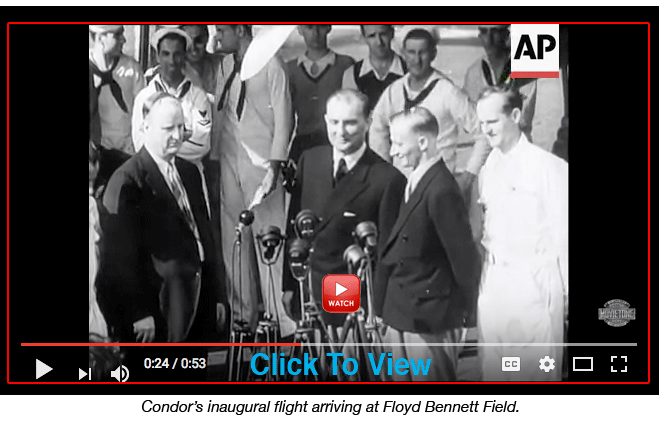 |
PAN AM WAKE UP CALL
The flight
caused a sensation, sent shock waves around
the world, and scared the hell out of Pan
American Airways, which had already established
the first commercial air service to Europe
utilizing a puddle-jumping flying boat,
the Sikorsky S42 aircraft.
The first
Pan Am flights went from Port Washington,
New York, to England via Shediac, New Burnswick,
and Botwood, into Foynes, Ireland, and onto
Southhampton.
In winter
those flights operated across a southern
route from Norfolk, Virginia, to Europe
via Bermuda, and the Azores into Lisbon
where they landed on the Tagus River.
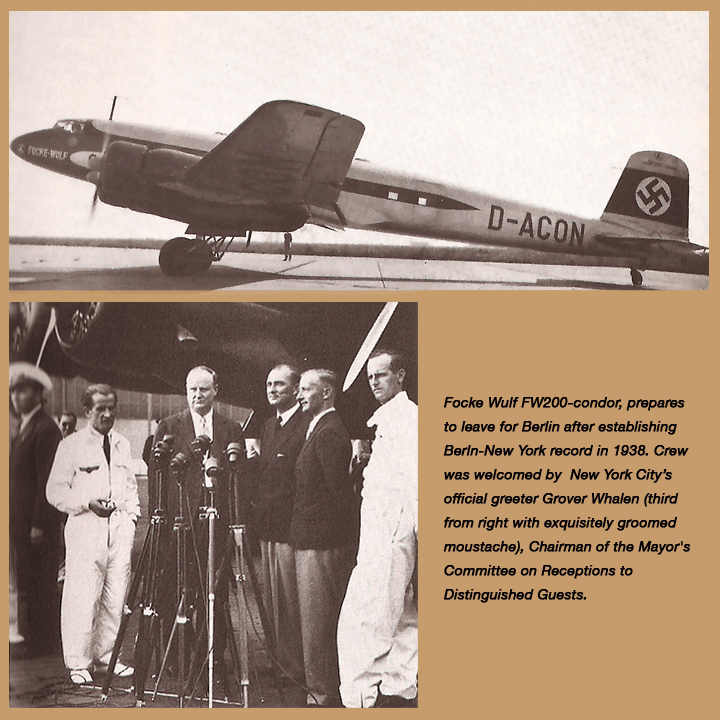 |
FW200
VERSUS B314
But by 1938
Pan Am had bet the airline on a dozen 100-ton
flying boats from Boeing—B314s, which
it planned to launch from Port Washington
to Europe in 1939, and then move over to
La Guardia Airport in New York City in 1940.
The B314 carried
more people (46 versus 23) and was a sound-deadened,
luxurious first class ride, but it was a
giant lumbering vehicle that operated low
and slow compared to the FW200. It’s
not unfair to say that the FW200 was like
the 1938 version of the fast-moving Concorde,
whereas the B314 was like every other slow-go
aircraft cruising the skies.
Of course,
WW II ended the high adventure and further
development of commercial air services,
and by 1945 Lufthansa was out of business
altogether.
But during
the conflict, both aircraft served—the
B314s as the only long-range aircraft in
the USA arsenal at onset, and the Focke-Wulfs
in various transport and other wartime duties
in Germany.
FINNAIR
ORDERED FW200S
We will never
know how the rivalry between B314 and FW200
might have panned out, although just imagining
the possibilities 80 yeara later is delicious.
The order
book for FW 200s was building at the dawn
of trans-Atlantic flight.
For example,
Finnair ordered the FW200 as early as 1941,
anticipating services to New York from Helsinki.
To generate
interest, handmade display models of the
first AY aircraft were actually part of
the Finland Pavilion at the 1939 World’s
Fair held in Flushing Meadow, just near
LaGuardia Airport in New York City.
For its part,
Germany had withdrawn from the World’s
Fair in 1939 after Poland, and with the
war looming any effort to further market
and sell FW200s on the international stage
was lost forever.
But undoubtedly
the FW 200 and its later, more developed
versions would have booked orders from U.S.
carriers including rival TWA, if not Pan
Am itself.
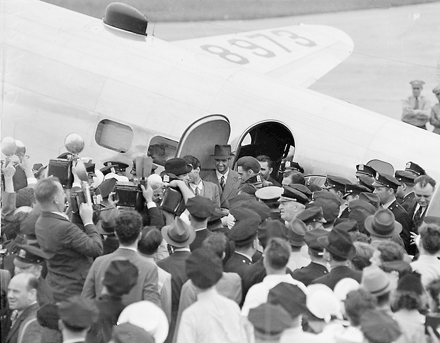 THE
TWA SCENARIO THE
TWA SCENARIO
TWA would
have been an especially intriguing customer
for the FW200 as the carrier was still five
years away from owner Howard Hughes’
move to operate the Lockheed Constellation.
It’s
worth noting that less than one month before
the Brandenburg’s arrival at Floyd
Bennett, on July 14, 1938, Howard Hughes
landed at the field after flying his Lockheed
14 around the world, setting a speed record
for that journey of 3 days, 19 hours, and
17 minutes.
How the 1939 World’s
Fair (in reality, a mega tradeshow) scenario
might haveimpacted not only Pan Am but also
the developing airline business can only
be imagined.
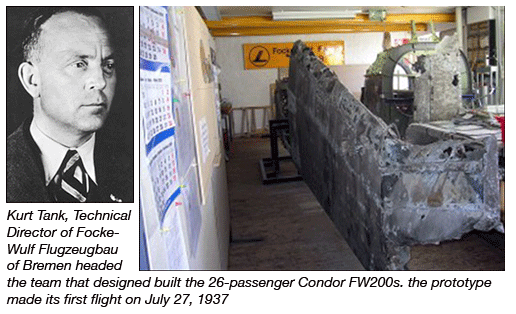 |
RETURN
FLIGHT ALSO SETS RECORDS
After its
historic flight to New York City, which
included a grand ride for the crew all the
way down Flatbush Avenue through Brooklyn
to Manhattan, the return flight of Brandenburg
to Germany on August 13, 1938, took 19 hours
and 47 minutes at an average speed of 205
MPH (330 km/h), riding the ever-sweet tailwind
from New York.
Later in November,
Brandenburg flew from Berlin to Basra, Karachi,
Hanoi, and Tokyo in only 46 hours and 18
minutes, but on the return flight D-ACON
ran out of fuel and ditched in the ocean
near Manila.
The 26-passenger Condor was designed, under
the leadership of Kurt Tank, technical director
of Focke-Wulf Flugzeugbau of Bremen, and
the prototype made its first flight on July
27, 1937.
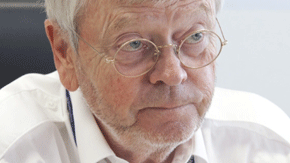 Alas,
today there are no FW200s left in the world,
although the remains of one that had ditched
in 1942, were discovered in 1981 at the
bottom of a Norwegian fjord near Trondheim. Alas,
today there are no FW200s left in the world,
although the remains of one that had ditched
in 1942, were discovered in 1981 at the
bottom of a Norwegian fjord near Trondheim.
In 1999, the
plane was salvaged by volunteers and the
German Museum of Technology in Berlin, but
broke apart while being lifted out of 60
feet of mud and water.
Undaunted,
the aviation enthusiasts, shipped the remains
of the FW200 home to Germany.
A retired
Airbus engineer named Guenter Bueker (left)
lead the restoration. To complete the project,
parts from another downed FW200 recovered
atop Kvitanosi Mountain near Voss in Norway
were used.
Although it
will never fly again, the beauty pictured
here is destined to be situate in a place
of pride at The German Museum of Technology.
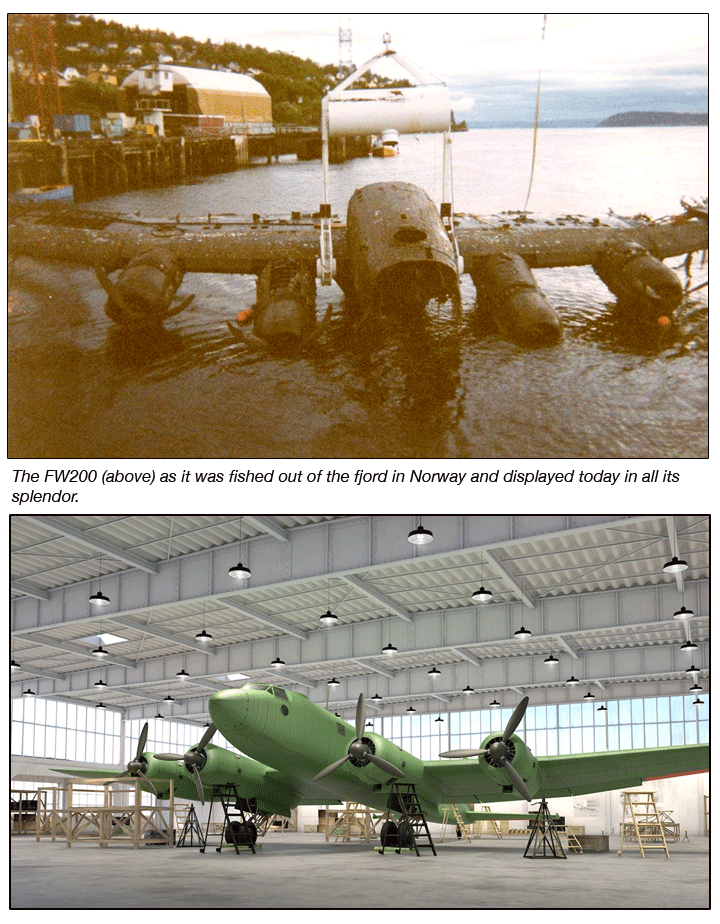 |
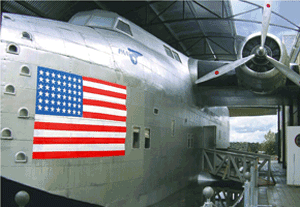 TOUCH
AND FEEL TOUCH
AND FEEL
The only B314
experience left in the world is at Foynes,
Ireland, where the Irish National Air Museum
has lovingly and faithfully recreated a
section and interior details of “The
Yankee Clipper,” attached to the museum’s
main building.
Geoffrey/Flossie
|
 |
Publisher-Geoffrey
Arend • Managing Editor-Flossie Arend • Editor Emeritus-Richard
Malkin
Film Editor-Ralph Arend • Special Assignments-Sabiha Arend, Emily
Arend • Advertising Sales-Judy Miller |
 Send
comments and news to geoffrey@aircargonews.com Send
comments and news to geoffrey@aircargonews.com
Opinions and comments expressed herein do not necessarily reflect the
views of the publisher but remain solely those of the author(s).
 Air
Cargo News FlyingTypers reserves the right to edit all submissions
for length and content. All photos and written material submitted to
this publication become the property of All Cargo Media. Air
Cargo News FlyingTypers reserves the right to edit all submissions
for length and content. All photos and written material submitted to
this publication become the property of All Cargo Media.
All Cargo Media, Publishers of Air Cargo News Digital and FlyingTypers.
Copyright ©2018 ACM, Inc. All Rights Reserved.
More@ www.aircargonews.com
 100%
Green 100%
Green
|
|






 Vol.
17 No. 47
Vol.
17 No. 47 Vol
17. No 48
Vol
17. No 48
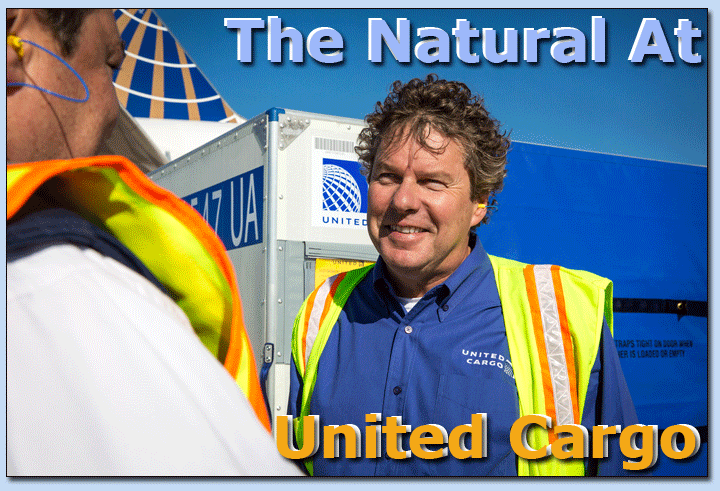




 THE
TWA SCENARIO
THE
TWA SCENARIO
 Alas,
today there are no FW200s left in the world,
although the remains of one that had ditched
in 1942, were discovered in 1981 at the
bottom of a Norwegian fjord near Trondheim.
Alas,
today there are no FW200s left in the world,
although the remains of one that had ditched
in 1942, were discovered in 1981 at the
bottom of a Norwegian fjord near Trondheim.
 TOUCH
AND FEEL
TOUCH
AND FEEL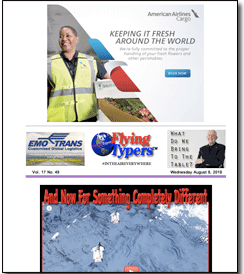
 Air
Cargo News FlyingTypers reserves the right to edit all submissions
for length and content. All photos and written material submitted to
this publication become the property of All Cargo Media.
Air
Cargo News FlyingTypers reserves the right to edit all submissions
for length and content. All photos and written material submitted to
this publication become the property of All Cargo Media.